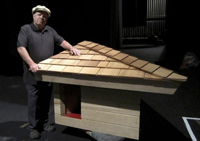 Wright's homes were for well-heeled, and one dog
Wright's homes were for well-heeled, and one dogSAN FRANCISCO
The Solomon R. Guggenheim Museum in New York City. The Fallingwater house in southwestern Pennsylvania. A doghouse?
Frank Lloyd Wright designed hundreds of landmark buildings and homes during a prolific career that spanned more than 70 years. But in what is widely considered a first and only for the famed architect, Wright indulged a young boy's humble request for a doghouse in 1956 and sent him designs.
"I was probably his youngest client and poorest client," said Jim Berger, now 68.
Berger rebuilt the doghouse last year with his brother, using the original plans. It is featured in a documentary and will be displayed during screenings starting this month.
Wright designed Berger's family's California home in the Marin County town of San Anselmo, prompting the then-12-year-old Jim Berger to ask his dad if Wright would design a home for his black Lab, Eddie. Berger's dad said he didn't know. So Berger decided to write to the great architect himself.
"I would appreciate it if you would design me a doghouse, which would be easy to build, but would go with our house," read the letter dated June 19, 1956. "[My dog] is two and a half feet high and three feet long. The reasons I would like this doghouse is for the winters mainly."
He explained that he would pay Wright from the money he made from his paper route.
"A house for Eddie is an opportunity," Wright wrote back. But he said he was too busy at the time and asked that Berger write him back in November. The boy did so on the first of the month, and the plan for the doghouse followed -- at no charge.
"The story of a 12-year-old kid having the chutzpah to write a letter to the greatest architect of all time and having him design something as modest as a doghouse. ... I just knew it was a great story," said Michael Miner, who produced and directed the documentary, "Romanza," which features the doghouse and other structures Wright designed in California.
The Dallas filmmaker is scheduled to screen the documentary at the Illinois State Museum in Springfield on March 25.
Screenings are to follow in Iowa, Georgia, Florida, New Jersey and New Hampshire. The doghouse will be on hand.
Berger said the original doghouse was not built until about 10 years after he received the designs. Since Eddie had died by then, Berger's father and brother built the house for another family dog.
That doghouse, however, later ended up in the dump because Berger said his mother did not have a dog and did not see much other value in it. He rebuilt it for the documentary last year, working off Wright's original plan, which said, "Plan of Eddie's house."
"When I wrote him originally to design the doghouse, I specified that it be real easy to build," said Berger, who became a cabinet maker. "It was a nightmare."
The roughly 3-foot-wide by 5-foot-long by 3-foot-high doghouse has a sharp triangular shape, with a sloping shingled roof. It is made of Philippine mahogany and weighs about 250 pounds.
Berger, who lives in the Sacramento area and has three rescue beagles, said he's not sure what he will do with the doghouse. Although his beagles are worthy of it, he said they would probably prefer to stay in the people house.
 Wright's homes were for well-heeled, and one dog
Wright's homes were for well-heeled, and one dog